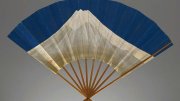The effect takes a moment to sink in: a double-sided folding fan, opulently painted in gold, silver, white, and azurite blue. On one side, the instantly recognizable profile of Mount Fuji, with its long, snow-covered slopes sweeping up toward the three-peaked summit; on the other side, the darker, M-shaped ridges of Mount Tsukuba. The natural transparency of the fan’s paper material allows the two images to coalesce, and the silhouette of each mountain defines the form of the other, appearing as a shadow in the background. “I think there’s something more here, a story we haven’t gotten to the bottom of yet,” said Rachel Saunders, the Harvard Art Museums’ Rockefeller curator of Asian art, during a gallery tour last winter. “This is an object that keeps me fascinated.”
Produced during the early nineteenth century, the fan was part of “Painting Edo: Japanese Art from the Feinberg Collection” (see harvardmag.com/edo-art-20), an exhibition earlier this year of more than 120 works dating to the Edo period—a 250-year span during which the arts flourished as Japan’s insular feudal society began opening to the world, and the city of Edo (modern-day Tokyo) transformed from a sleepy fishing village to an enormous, thriving metropolis, the de facto capital of the shogun’s government. The exhibit drew from a massive collection promised to the University by Robert Feinberg ’61 and Betsy Feinberg.

Photograph courtesy of the Harvard Art Museums/Promised gift of Robert S. and Betsy G. Feinberg
In a gallery filled with golden-age masterpieces, the fan held a particular kind of meaning. It was painted toward the end of the Edo period by Suzuki Kiitsu, an accomplished acolyte of the School of Kōrin (often called Rinpa) style, characterized by brilliant colors, metallic finishes, and highly stylized, decorative designs. Within that tradition, Kiitsu became known for his crisp detail work and surprising, inventive compositions.
The two mountains he painted on the fan were both sacred in Japanese tradition. Fuji “was worshipped for hundreds of years,” said Saunders, who co-curated the exhibit, “and there was a very lively cult around the mountain, this sacred landscape, during the Edo period.” It lay to the west of the city; Mount Tsukuba lay to the northeast, a less auspicious direction. According to onmyōdō, a Japanese spiritual and philosophical practice drawn in part from the principles of yin and yang, the northeasterly direction was considered a “demon gate” through which evil spirits passed. “So you need a sacred mountain to keep your city safe,” Saunders said. Or, even better, two. “And if you think about it in those terms,” she continued, “the person who’s holding the fan has a fictive viewing position where they’re standing between those two protective sacred mountains.” Standing, in other words, in the city of Edo. “It’s just beautiful,” she said. “It is emblematic of a playful, nimble, sophisticated, witty mode of transmitting experience to pictorial format.”








